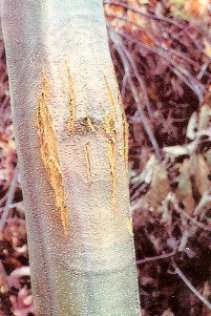Cryphonectria
Cryphonectria is a fungal genus in the order Diaporthales. The most well-known and well-studied species in the genus is Cryphonectria parasitica, the species which causes chestnut blight. The genus was, for a time, considered synonymous with Endothia, but the two are now recognised as distinct. Taxonomic studies in 2006 limited the genus to four species, but a fifth, Cryphonectria naterciae, was described in 2011 from Portugal.[1]
| Cryphonectria | |
|---|---|
 | |
| Cankers caused by the Cryphonectria parasitica cause the bark to split. | |
| Scientific classification | |
| Kingdom: | Fungi |
| Division: | Ascomycota |
| Class: | Sordariomycetes |
| Order: | Diaporthales |
| Family: | Cryphonectriaceae |
| Genus: | Cryphonectria (Sacc.) Sacc. & D. Sacc. 1905 |
| Species | |
|
See text. | |
Species
- Cryphonectria abscondita
- Cryphonectria acaciarum
- Cryphonectria cubensis
- Cryphonectria decipiens
- Cryphonectria japonica
- Cryphonectria macrospora
- Cryphonectria moriformis
- Cryphonectria naterciae
- Cryphonectria nitschkei
- Cryphonectria parasitica
- Cryphonectria variicolor
According to [(Murr) (And.et And.)] Chestnut blight was first discovered in North America in 1904 on Castanea dentata. By the 1940s it had killed most wild American chestnut trees, which were formerly one of the most abundant species in the eastern U.S.
The infection takes place through bark wounds. In the early stage, clear yellow-brown spots appear on the young twigs; the bark then splits open, sinks in and dies out. In the next stage the cambium layer is infected, the tree trunk becomes disformed, the split bark parts start to swell as parasitic fungus produces more peridermia and yellow colored pycnidia start to appear on the bark. Then the tree's leaves wilt and branches start dying off. The release of fungal spores lasts through the whole vegetative season.
References
- Helena Bragançaa, Daniel Riglingb, Eugénio Diogoa, Jorge Capeloa, Alan Phillipsd and Rogério Tenreiroc (2011). "Cryphonectria naterciae: A new species in the Cryphonectriae-Endothia complex and diagnostic molecular markers based on microsatellite-primed PCR". Fungal Biology. 115 (9): 852–861. doi:10.1016/j.funbio.2011.06.014. PMID 21872182.CS1 maint: uses authors parameter (link)